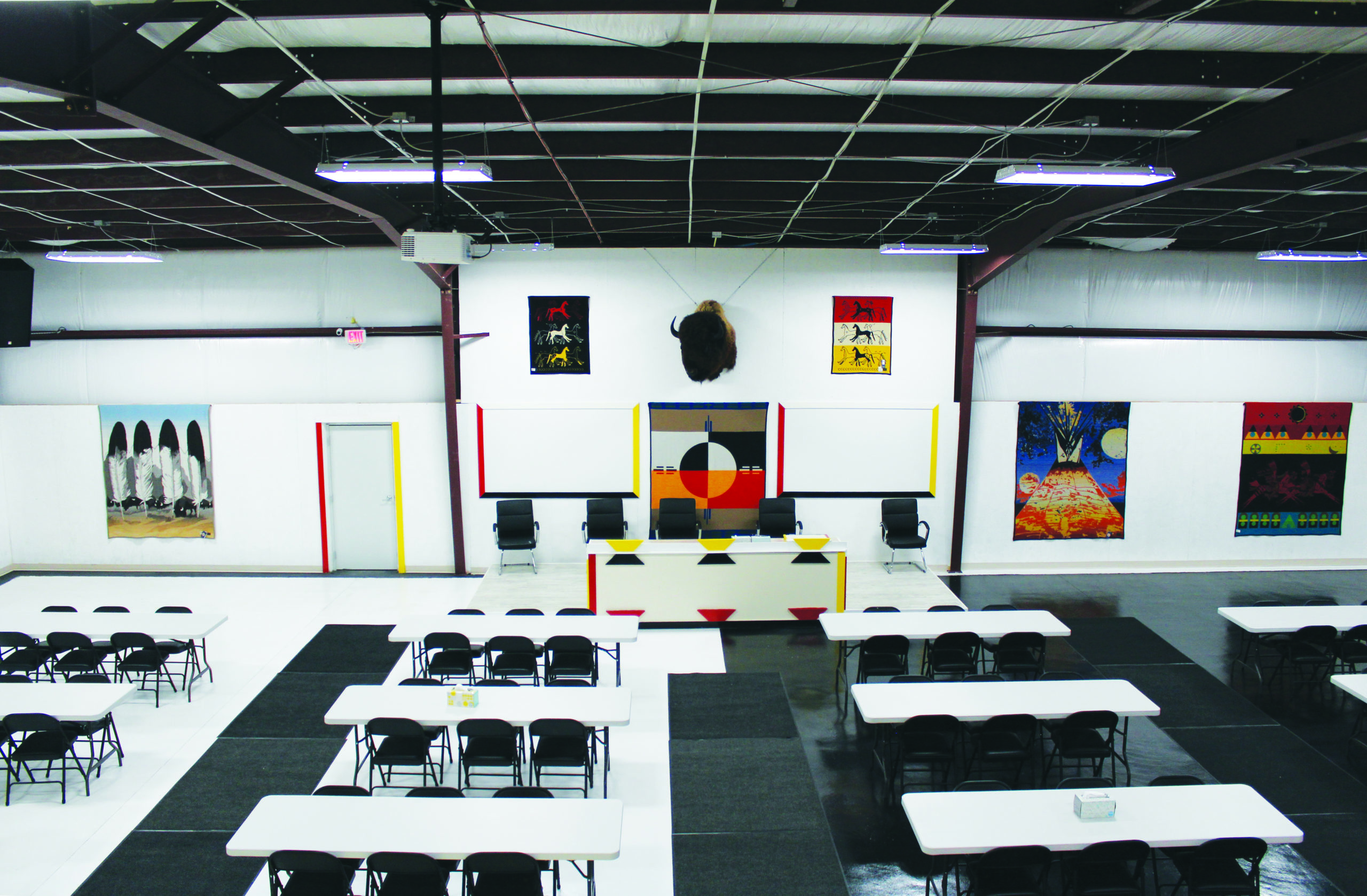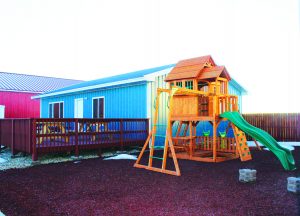Making a comeback

The Wakpamni Lake Community Corporation’s community building is complete and they are ready to host community events. A May Grand Opening is planned for the new facility. (Photo by Ernestine Anukasan)
BATESLAND – Upon arriving at the Town Center built by the Wakpamni Lake Community Corporation, one cannot help but be impressed with what this small community has accomplished in spite of megalithic setbacks.
The Wakpamni District, with a population of approximately 5,000, is one of nine districts located on the Pine Ridge Indian Reservation in Southwest South Dakota. Each district elects its own officers and acts as an independent government entity, separate from the tribal government.
The Wakpamni District is located in the south central area of the reservation with a terrain of rolling hills and prairie grasslands. Much of the income produced is from farming, ranching and the cattle industry.
However this area of the country remains one of the poorest with a yearly per capita income of $10,148 (U.S. 2018 Census). The area is also sparsely populated (6.5 people per square mile) providing very few customers for businesses with little or no infrastructure to support industrial development.
So the Wakpamni Lake Community Corporation an arm of the Wakpamni District knew that in order to pull themselves out of poverty they would need to be innovative, reach outside the box.
So they tried their hand at Pay-Day lending which attracted nationwide customers, earning $5 per loan, but because of federal regulations they were shut down.
Then in 2014 they thought they had found the perfect economic development opportunity when they met a man named John Galanis.
According to Geneva Lone Hill, President of the Wakpamni Lake Community Corporation, in 2014 members of the WLCC had traveled to the Reservation Economic Summit (RES2014) in Las Vegas seeking economic opportunities where they met John Galanis.
So when WLCC entered into a partnership with what they believed were reputable representatives of Burnham Securities which was pitched as co-owned by Hunter Biden, the Vice-President’s son and others, they believed it was the answer to their hopes and dreams for a better tomorrow.
According to Lone Hill the money generated would have given the Wakpamni District ample capital to invest in a warehouse where they could ship goods they had produced locally, a laundromat, a bakery, a community building for Bingo and community events, a tutoring facility to teach Lakota language, an incubator for business start-ups, a sewing center and a bowling alley.
When WLCC received an initial payment of $2,250,000, which was held in trust by U.S. Bank, Lone Hill said the community broke ground on construction of their warehouse.
However Galanis turned out to be a conman who had contrived a complicated scheme to defraud several trust funds out of $60 million using the Wakpamni Lake Community Corporation as a front.
So after the investigation and trials in the Galanis bond sale scheme, construction at Wakpamni Lake came to a standstill. Becoming the victims of such a massive public scandal, community members became skeptical and fearful.
However Geneva Lone Hill, President of the Wakpamni Lake Community Corporation said, “Nothing was happening so we decided to keep moving forward. We decided we can’t be fearful forever. We couldn’t go on like this forever.”
And move forward they did. Albeit, not by the huge leaps and bounds promised by the fraudsters, but instead they have been attaining their goals one small step at a time.
The saying “Success is the sum of small efforts repeated day in and day out,” holds true for members of the Wakpamni district who didn’t let the unscrupulous dealings of a few unethical Wasicu hold them down.
“It’s been a real uphill battle but we are not giving up,” Lone Hill said. “We had that major setback. It would be so easy to just give up, but we continue to move ahead.”
Week after week and sometimes twice a week, the community has been hosting BINGO in the old gym at the Oglala Lakota County School in Batesland. All the prizes are donated by community members and people come from all over the reservation to try their hand at winning the jackpot.
Not only are the prizes donated by community members, but so is the food that is prepared and sold during BINGO. The day Native Sun News Today visited, the specialty of the house was chili and frybread as well as delicious homemade cinnamon rolls.
They also serve daily lunches. The food is donated by Lone Hill’s family, Sandy Two Lance’s family and other community members and as well as the time and effort put forth to bring their community back from the brink.
After years of figuring out what needed to be accomplished, breaking up what may have seemed like massive, megalithic goals into tiny unimposing ones, the Town Center they envisioned is nearly finished.
Lone Hill shared that the road leading to the Town Center and the Wakpamni Lake Community was once gravel and when it rained turned into a muddy mess. She said it was one of the last roads on the reservation to be paved.
“We were so happy when we got it paved. We used to take extra clothes because sometimes we had to push our cars out of the mud,” she laughed.
Lone Hill grew up just down the road from the Town Center and laments that the much of the family homestead is inaccessible due to flooding in recent years. Lone Hill owns the land on which the Town Center is built.
Standing proudly in front of the four buildings that make up the Town Center was Richard Shangreaux, the contractor who built this impressive complex. In the center of the complex his crew built a fire pit where families can gather for birthdays, or other celebrations and enjoy the outdoors.
The first building is slated for a laundromat and a bakery and could possibly serve as an incubator for other small businesses Shangreaux said. While the building is not yet complete it is well on the way to being done and will serve as a mini-mall and could possibly house a hair salon and an arcade as well.
The next structure is the community building which Shangreaux artfully decorated with traditional four direction colors. The flooring is equally divided into the red, white, black and white décor. All of the pictures on the walls that display Lakota words and their meaning are also framed in the medicine wheel color scheme as well as the door frames and podium. A huge buffalo head mount graces the wall overlooking the center.
“The community building is ready to go and the OST council already held a meeting here,” Lone Hill said. With a built in state-of-the-art kitchen facility, the building is ready to house BINGO and other community events.
 The next building in the center of the complex is the tutoring center which is also complete. It is set up with computers and cubby’s where students can learn the Lakota language using the Tiyospaye concept, wherein elders teach the younger generation’s traditional Lakota culture.
The next building in the center of the complex is the tutoring center which is also complete. It is set up with computers and cubby’s where students can learn the Lakota language using the Tiyospaye concept, wherein elders teach the younger generation’s traditional Lakota culture.
The fourth building is a warehouse built for industrial production and shipping. It has office space, and three large bays. The first and second bay are large enough to house industrial sewing machines and contains enough room for large scale manufacturing.
The last bay is built for shipping the goods produced by local tribal employees and currently houses a fire truck.
Lone Hill said there is currently a R.V. company from Wisconsin looking at their facility for large scale production of R.V. seats, pillows, mattresses and other R.V. equipment.
She said they could also produce piecework for the military or star quilts for Indian casinos.
The possibilities are endless, but whatever industry they chose to partner with Shangreaux said, “It must be the right fit.”
Lone Hill said they are planning for a May Grand Opening event that will showcase what a small community can accomplish one small step at time.
They are currently taking proposals from companies that are interested in utilizing their facility. For the past several years they have been preparing for this day and they are ready to take on the challenge.
They are also seeking funding opportunities as the recent scandals have hurt them economically.
The Oglala Lakota Nation is designated as a Promise Zone, a 10-year federal designation, where companies are eligible for various tax credits that is designed to create jobs and encourage investment in poverty stricken areas.
(Contact Ernestine Anukasan at production@nativesunnews.today)
